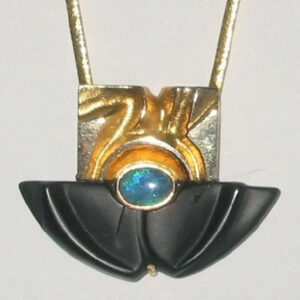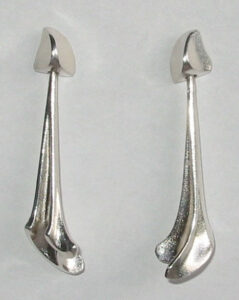
Zoltan Popovits (b. 1940)
Lapponia
The Finnish company Lapponia Jewelry, founded in 1960 by Pekka Anttila, is well known for artistic and sculptural designs. Highly original and often with names that leed the thought to times and places in between history and old sagas or dreams, the designs speak to the subconcious and seem to be related to magic amulets or primitive tribe jewelry – only with a futuristic form language. Designers such as Björn Weckström, Poul Havgaard and Zoltan Popovits have created series of jewelry that are today considered highly collectible as well as a personal statement when worn.
Zoltan Popovits enters the scene

‘New Fire’ series
Gold, black Onyx and Opale.
Zoltan Popovits is Hungarian by birth. He studied architecture and art in the USA, at the University of Colorado and Kansas City Art Institute, and came to Finland on a Fulbright scholarship at the Finnish Academy of Art in 1965. After working with sculpture and ceramics, on his own and with the renowned Arabia ceramics factory (1969-71), he came to work as a designer for Lapponia in 1975.
The techniques
The metal in Popovits jewelry seemes folded, and draws the thoughts to origami, Japanese paper folding art. This is also the name of his 2000 collection. His first jewelry series was launched in 1978. The kinetic drop shaped earrings ‘Calliope’ with organic plant like design are typical of this series. In the 1980’s the lines became more flowing and the proportions grew lager. Influences from the Art nouveau era were melted into the wellknown Lapponia look created by Björn Weckström.
Materials
Like Weckström, Popvits has also been interested in combining different materials in new ways. The use of contrasting black is one of Zoltan Popovits traits, starting in 1981 with combining silver with Ebony and later from 1984 gold with black Onyx, often combined with Opales, Diamonds and Pearls. With the pieces of wood and the Onyx, cut in unique shapes by the German Dieter Lorenz, Popovits fascination in the expressiveness of primitive jewelry becomes clear. In the magic of nature and its spirits he seeks individuality and meaning that can connect the piece of jewerly to it’s wearer.


Silver.

Table of Contents
Toggle